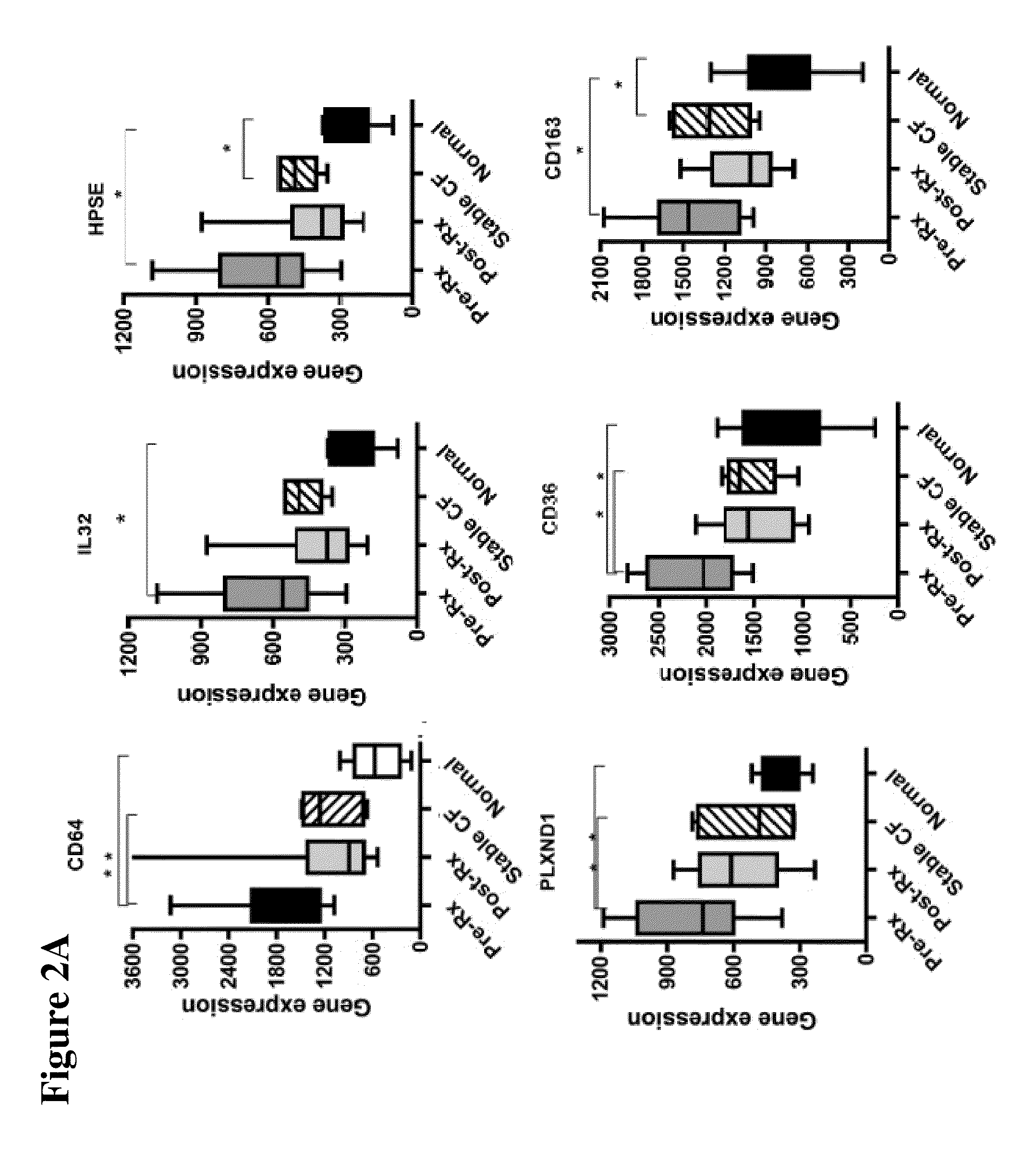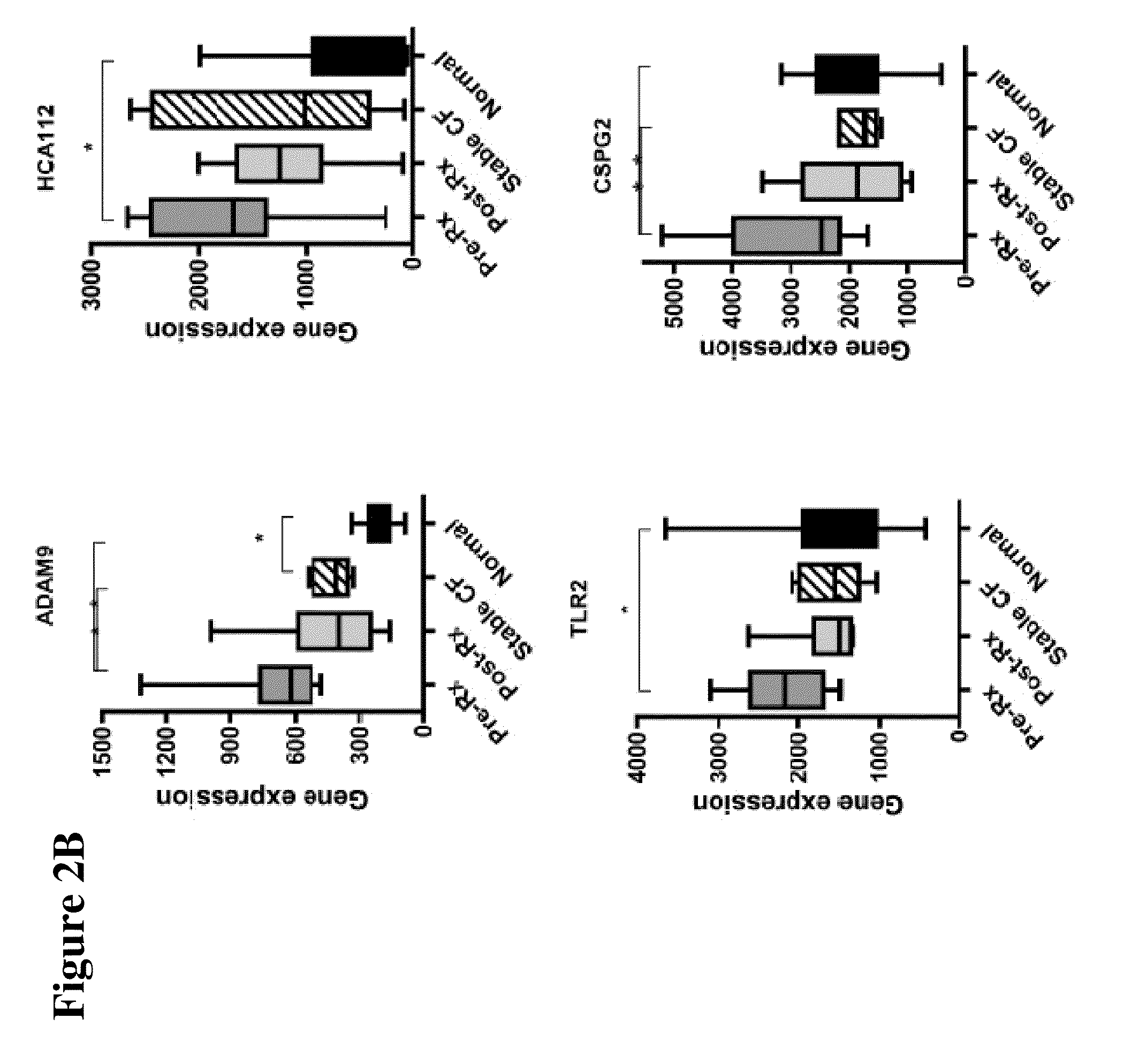Markers for Diagnosis of Pulmonary Inflammation and Methods Related Thereto
a pulmonary inflammation and diagnostic technology, applied in the field of genetic markers, can solve the problems of slow and gradual progression of fibrosis and remodeling, hampered delivery of rapid and efficient clinical trials in cf and other diseases associated with airway inflammation, and sensitive measures of treatment respons
- Summary
- Abstract
- Description
- Claims
- Application Information
AI Technical Summary
Benefits of technology
Problems solved by technology
Method used
Image
Examples
example 1
[0039]This example illustrates the overall design and step-wise execution of the study described herein.
[0040]The design of the study is shown in FIG. 1. Peripheral blood mononuclear cells (PBMCs) were isolated from 10 CF patients in the Development Cohort with acute pulmonary exacerbations before and after therapy, as well as healthy non-CF control subjects and stable CF patients matched in age and sex to the patients of Development Cohort. Gene expression profiling was performed by utilizing gene microarray technique to identify genes whose expression significantly changed with treatment. Thus, candidate gene markers, differentially regulated before and after antibiotic therapy were identified. These genes were independently confirmed in the same set of samples, utilizing quantitative RT-PCR.
[0041]Further, these markers were tested for their ability to classify therapeutic response in an independent Validation Cohort of 14 acutely ill CF patients, utilizing reverse transcription-P...
example 2
[0043]This Example describes the initial study performed with patients in the Development Cohort for identification of the genetic markers.
[0044]Patient recruitment was done as follows. Subjects >18 years of age with CF (based on sweat chloride testing and genotype) were enrolled at the time of admission or home IV antibiotic initiation for a clinically diagnosed pulmonary exacerbation at a large Cystic Fibrosis Foundation accredited adult CF clinic, following obtainment of informed consent from the study subject. All study participants were monitored by the National Jewish Health and University of Colorado Institutional Review Boards. Patients identified for enrollment met CF Foundation Clinical Practice Guidelines of at least 3 of 11 criteria for an acute pulmonary exacerbation (Foundation, C. F. Clinical Practice Guidelines for Cystic Fibrosis).
[0045]All patients were treated with at least 2 antibiotics targeting their specific bacterial pathogens for a minimum of 2 weeks and a m...
example 3
[0066]This Example illustrates the diagnostic value of the CF therapeutic signature in association with % change in FEV1 and demonstrates that the gene expression values from the CF therapeutic signature enhance the predictive discriminating value of FEV1 alone.
[0067]In a multivariate analysis, the combined explanatory power of FEV1 in combination with gene expression values was evaluated. Utilizing Generalized Estimating Equations, multivariate logistic regression models were constructed predicting resolution of acute pulmonary exacerbations as a function of FEV1% predicted, and the discriminative value of combinations of genes identified by the development cohort (SAS, SAS Institute Inc., Cary, N.C.). An unstructured correlation structure between time points was utilized, and a stepwise selection procedure chose the most significant combination of FEV1 improvement and transcript changes. FEV1% predicted was forced into modeling due to its known clinical reliability, as a standard ...
PUM
| Property | Measurement | Unit |
|---|---|---|
| width | aaaaa | aaaaa |
| volume | aaaaa | aaaaa |
| volume | aaaaa | aaaaa |
Abstract
Description
Claims
Application Information
 Login to View More
Login to View More - R&D
- Intellectual Property
- Life Sciences
- Materials
- Tech Scout
- Unparalleled Data Quality
- Higher Quality Content
- 60% Fewer Hallucinations
Browse by: Latest US Patents, China's latest patents, Technical Efficacy Thesaurus, Application Domain, Technology Topic, Popular Technical Reports.
© 2025 PatSnap. All rights reserved.Legal|Privacy policy|Modern Slavery Act Transparency Statement|Sitemap|About US| Contact US: help@patsnap.com



